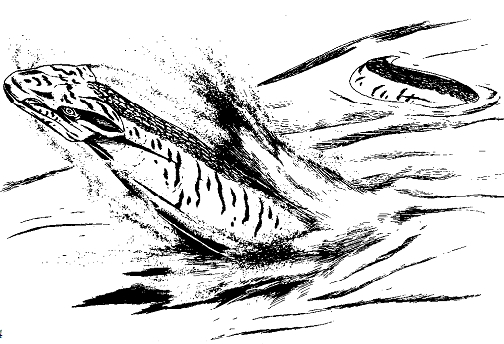Sand Dragon
Created by Gregory Detwiler

FREQUENCY: Very rare
NO. APPEARING: 1
ARMOR CLASS: 0
MOVE: 12?//24? (9? in sand)
HIT DICE: 10-12
% IN LAIR: 60%
TREASURE TYPE: H, S, T
SPECIAL DEFENSES : Low armor class,
use, surprise on 1-9 on 1d10, high intelli-
gence
acute senses, saving-throw bonuses,
magic resistance
NO. OF ATTACKS: 2 claws and 1 bite
DAMAGE/ATTACK: 1-8/1-8/2-20
SPECIAL ATTACKS: Breath weapon, spell
MAGIC RESISTANCE: 20%
INTELLIGENCE: Exceptional
ALIGNMENT: Neutral
SIZE: L (38? long)
PSIONIC ABILITY: Nil
CHANCE OF:
Speaking: 80%
Magic Use: 80%
Sleeping: 30%
LEVEl/XP VALUE: 10 HD: VIII/4,950 + 14
per hit point; 11-12 HD: IX/7,250 + 16
per hit point
Sand dragons are of a unique race of
dragons which inhabit warm climates with
large, sand-covered areas such as deserts
or beaches. Sand dragons can be easily
identified by their long, wormlike bodies
and their four short, muscular legs which
end in webbed feet suitable for digging
and swimming. The dragon?s head is
diamond-shaped and flat, with bright blue
eyes. A sand dragon?s body has rows of
seashell scales lining the back, from the
base of the skull to the tip of the forked
tail. The color of the dragon?s hide varies
with its natural environment; desert dwell-
ers are brown in color, and beach dwellers
are white.
Sand dragons are, for the most part,
nonaggressive creatures. They will speak
with adventuring parties, and may even
aid them with information. However,
when provoked, sand dragons can become
powerful enemies. The devastating breath
weapon of the sand dragon is a ray 2?
wide and 120? long, which turns any living
thing it touches into pure, loose, white
sand (save vs. breath weapon at + 1).
Restoration of a character is possible only
with the use of a wish, though some
reports have indicated that desperate
adventurers successfully used rock to
mud, mud to rock, stone shape, and stone
to flesh (in that order) to restore charac-
ters, and achieved success against all
expectations.
Sand dragons gain magic-user and druid-
ic spells by age level, though they do not
otherwise function as druids and must
learn these spells from other sand dragons
as they grow up. Only verbal components
are required to cast these spells, which are
acquired as follows:
Very young: One first-level magic-user
spell
Young: One first-level druidic spell
Subadult: One second-level magic-user
spell
Young adult: One second-level druidic spell
Adult: One third-level magic-user spell
Old: One third-level druidic spell
Very old: One fourth-level magic-user spell
Ancient: One fourth-level druidic spell
Sand dragons bury the&elves beneath
the sand to sleep and hide from their
enemies. When hidden, sand dragons are
completely camouflaged and undetectable.
When they choose, they pop their heads
from beneath the sand, surprising their
enemies 90% of the time. Sand dragons
can hold their breath for up to half an
hour in any environment.
The sand dragon often has a fixed lair,
though it tends to wander over great
distances. Treasures are important to
dragons, and the sand dragon is no excep-
tion. The sand dragon?s belongings are
usually buried deep beneath the lair?s
floor.
The reproductive process of the sand
dragon is relatively slow. Every 10 years,
the female dragon lays three eggs, buries
them deep beneath the sand, and aban-
dons them. One year later, the eggs hatch,
and the infant sand dragons must seek out
their parents or other sand dragons in
order to be brought into the loose commu-
nity of their kind and to be educated in
magic. Few sand dragons survive to adult-
hood near civilized areas, and this breed is
usually found only in uninhabited deserts.